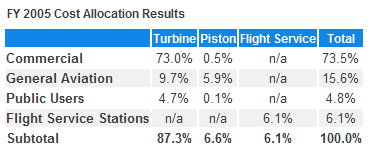Wed, Feb 14, 2007
Agency Worked With National Accounting Firm To Determine
Allocations
 How did the Federal Aviation
Administration arrive at its decision to increase fees operators of
smaller aircraft would pay under its proposed new funding scheme?
The FAA states it worked with accounting firm
PriceWaterhouseCoopers to designed what the agency calls "a simple,
transparent, thorough, and repeatable cost allocation
methodology."
How did the Federal Aviation
Administration arrive at its decision to increase fees operators of
smaller aircraft would pay under its proposed new funding scheme?
The FAA states it worked with accounting firm
PriceWaterhouseCoopers to designed what the agency calls "a simple,
transparent, thorough, and repeatable cost allocation
methodology."
The FAA used FY 2005 Cost Accounting System data -- which the
agency says is the most detailed and comprehensive cost data
available as the proposal was being developed -- to distinguish
between two types of users:
- Turbine-powered aircraft (jets and turboprops)
users drive most system costs because they fly in all weather, at
all times of the day, tend to be time-sensitive, generally compete
for the same air traffic control resources, and require complex air
traffic equipment and procedures.
- Piston aircraft and helicopter users, who
typically fly lower and slower than turbine pilots. These aircraft
typically fly less complex equipment, tend to be less time
sensitive, frequently fly under visual flight rules, and require
different types of air traffic control resources.
The FAA allocated the costs of more than 600 Cost Accounting
System projects between these two user types and determined that,
in most cases, piston users were responsible for only a share of
incremental costs. The total FY 2006 air traffic costs were
allocated as follows:

- 87% to turbine users,
- 7% to piston users, and
- 6% to flight service stations (expected to decline in future
years).
Within each group, the FAA divided costs among commercial,
general aviation and public users based on their share of activity.
In the terminal environment, the allocation looks at costs and
activity within groups of similarly-sized airports. As a result,
users of less costly facilities do not bear the costs of more
expensive facilities.
This table summarizes the FY 2005 cost allocation results,
according to the FAA:

Flight Service Station costs are not allocated among users,
because costs are expected to decline substantially in future years
(one assumes, due to increased privitization of the service --
Ed.) and the cost recovery proposal funds these costs from the
General Fund.
More News
Aero Linx: Model Aeronautical Association of Australia MAAA clubs are about fun flying, camaraderie and community. For over 75 years, the MAAA has been Australia’s largest fl>[...]
Touchdown Zone Lighting Two rows of transverse light bars located symmetrically about the runway centerline normally at 100 foot intervals. The basic system extends 3,000 feet alon>[...]
“Discovery and innovation are central to our mission at Virgin Galactic. We’re excited to build on our successful record of facilitating scientific experiments in subor>[...]
How To Get A Story On Aero-TV News/Feature Programming How do I submit a story idea or lead to Aero-TV? If you would like to submit a story idea or lead, please contact Jim Campbel>[...]
Student Pilot Reported That During Rotation, “All Of A Sudden The Back Of The Plane Kicked To The Right..." Analysis: The student pilot reported that during rotation, “>[...]
 ANN's Daily Aero-Linx (05.02.24)
ANN's Daily Aero-Linx (05.02.24) ANN's Daily Aero-Term (05.02.24): Touchdown Zone Lighting
ANN's Daily Aero-Term (05.02.24): Touchdown Zone Lighting Aero-News: Quote of the Day (05.02.24)
Aero-News: Quote of the Day (05.02.24) ANN FAQ: Contributing To Aero-TV
ANN FAQ: Contributing To Aero-TV NTSB Final Report: Cirrus Design Corp SR20
NTSB Final Report: Cirrus Design Corp SR20





